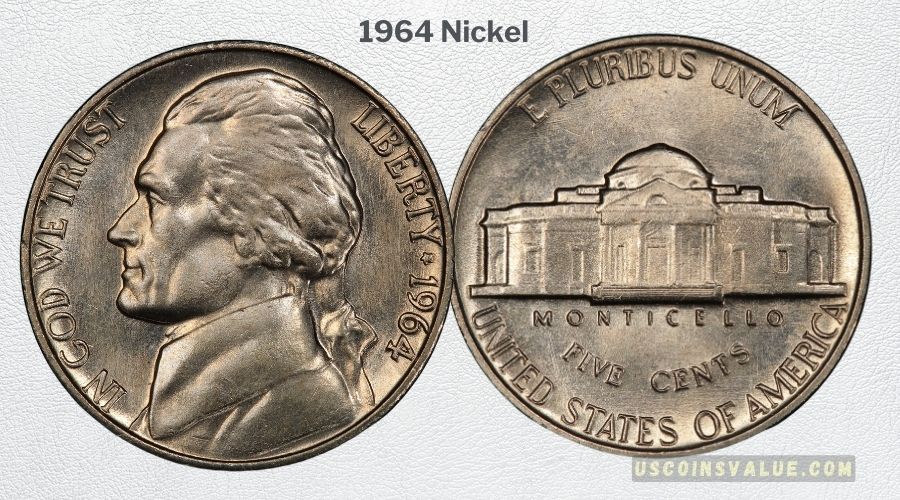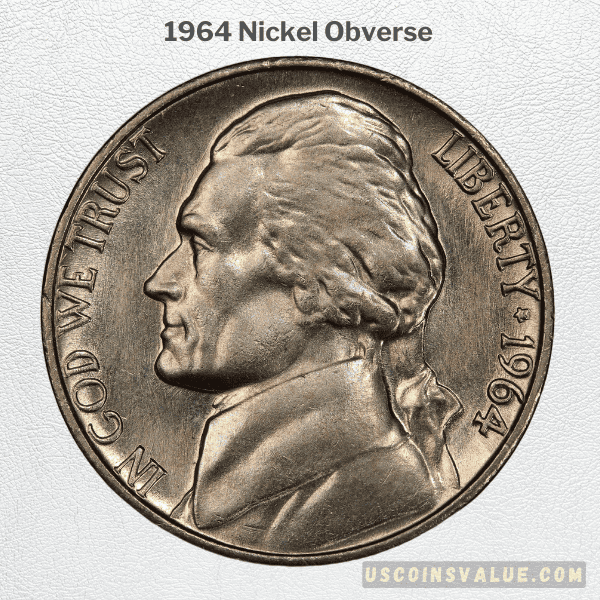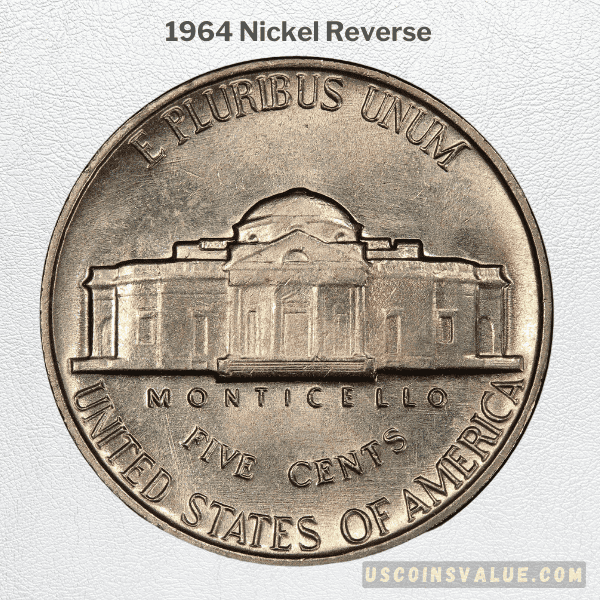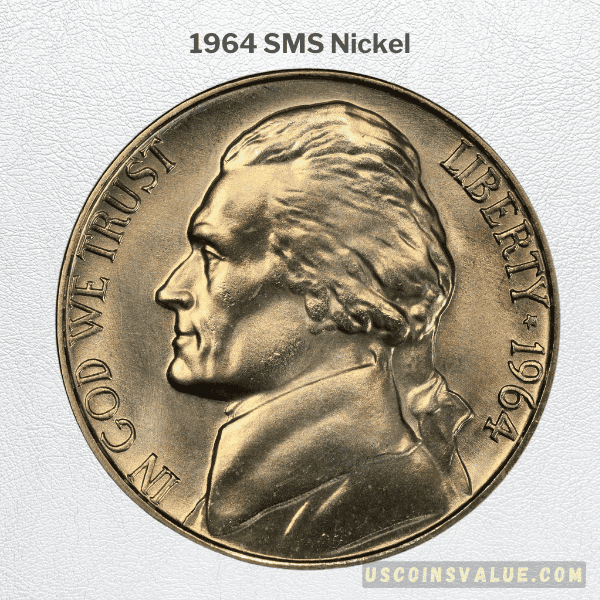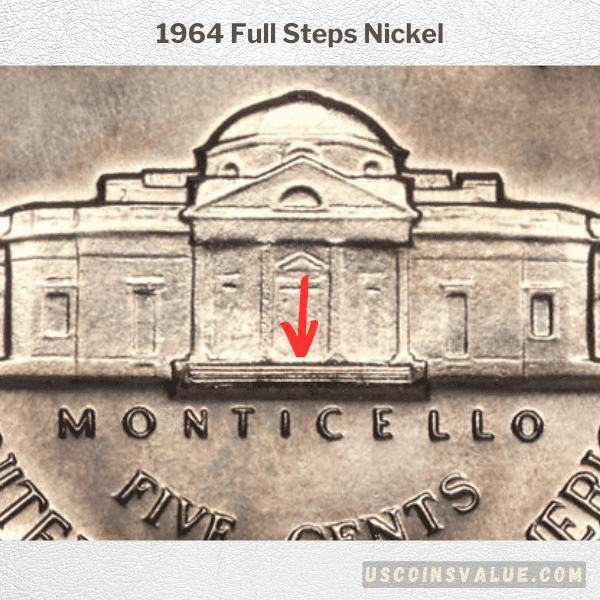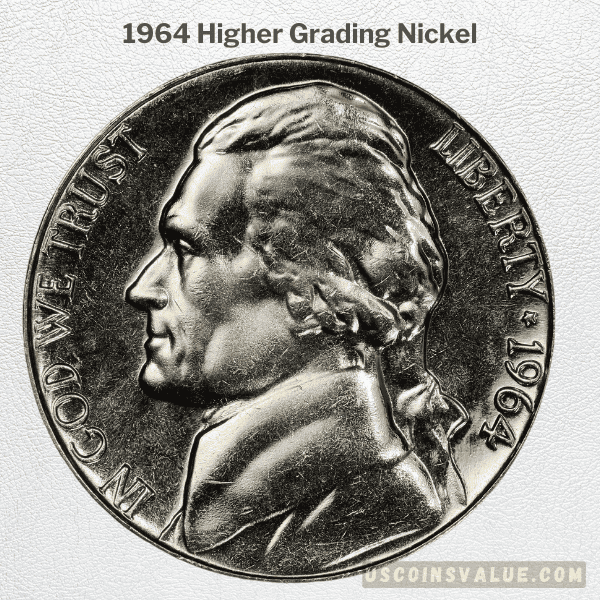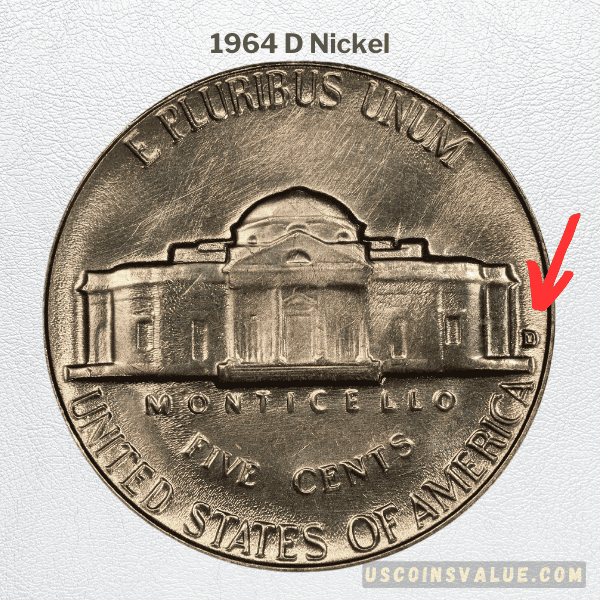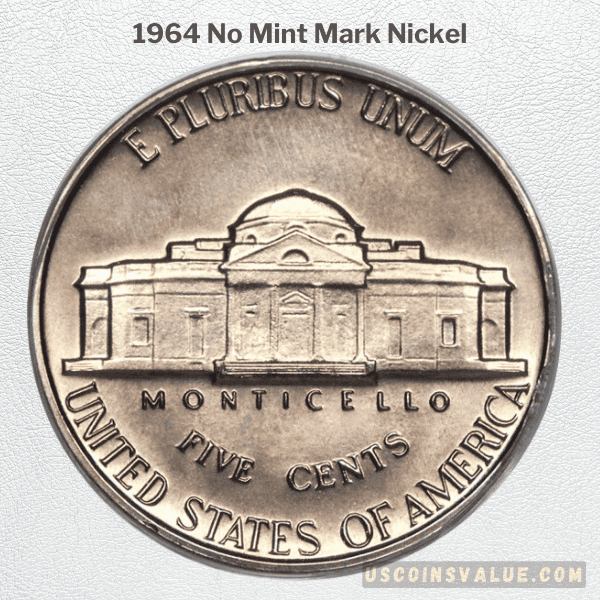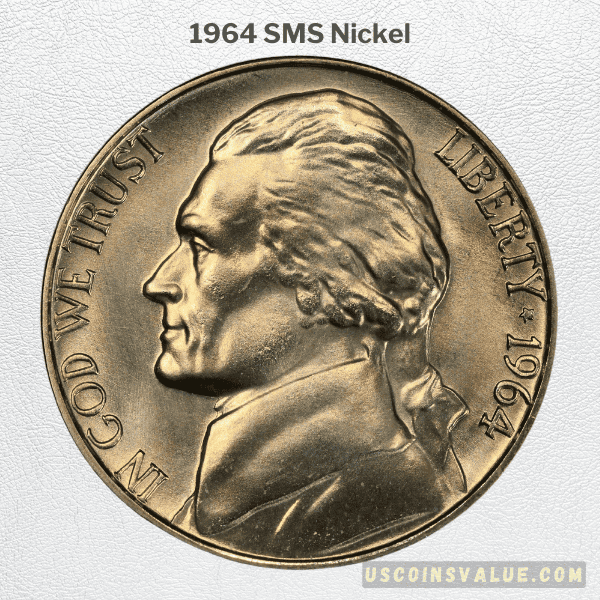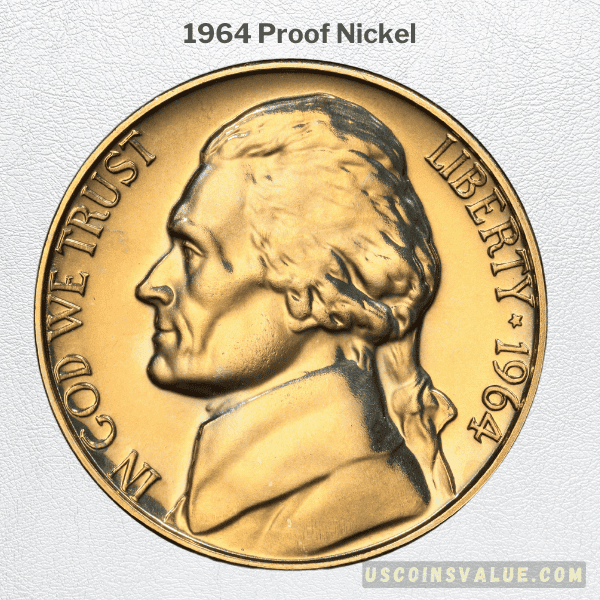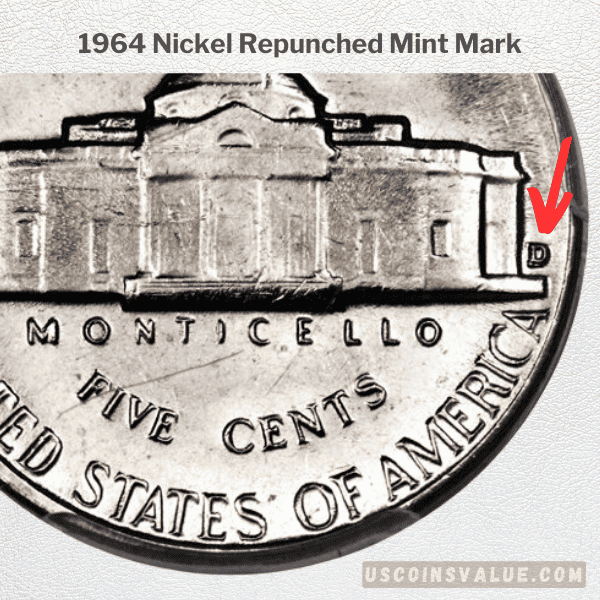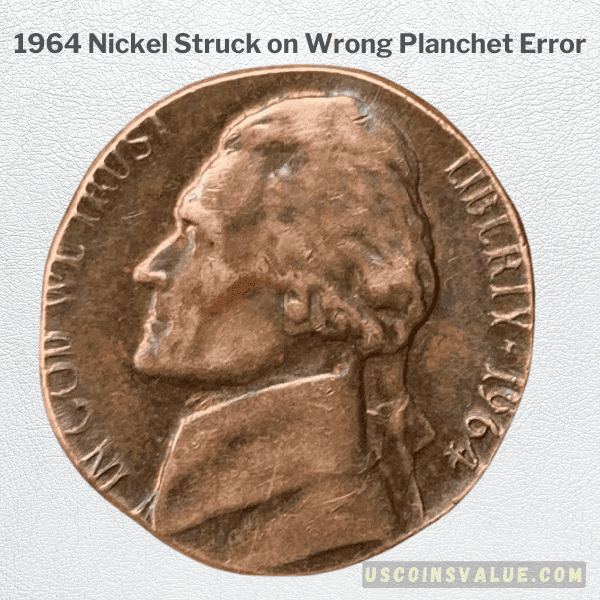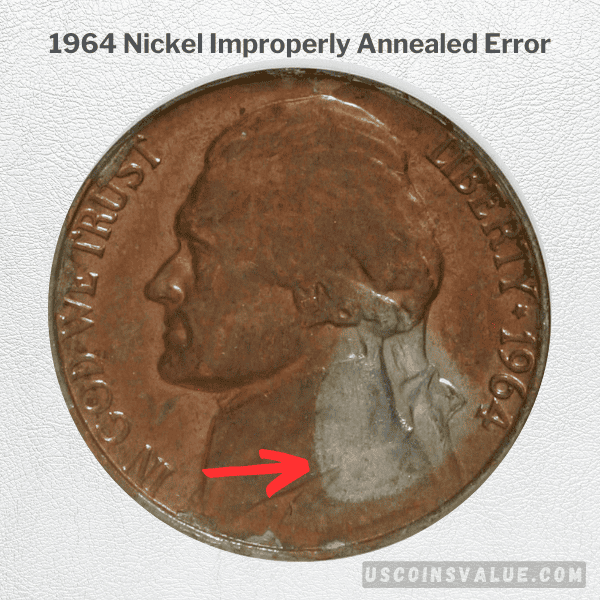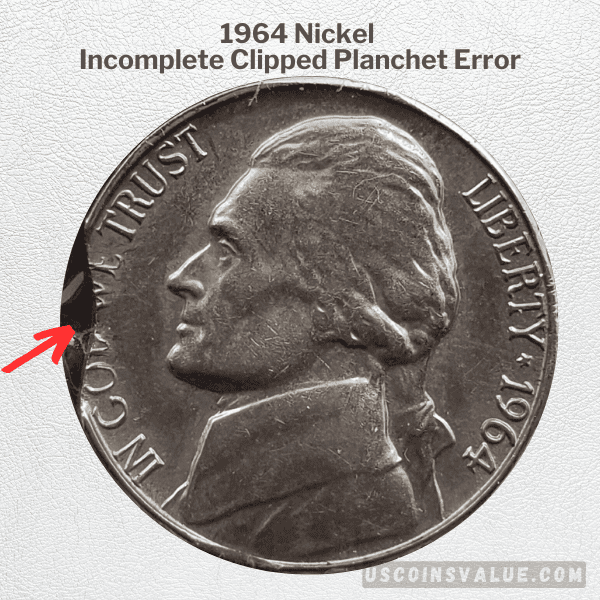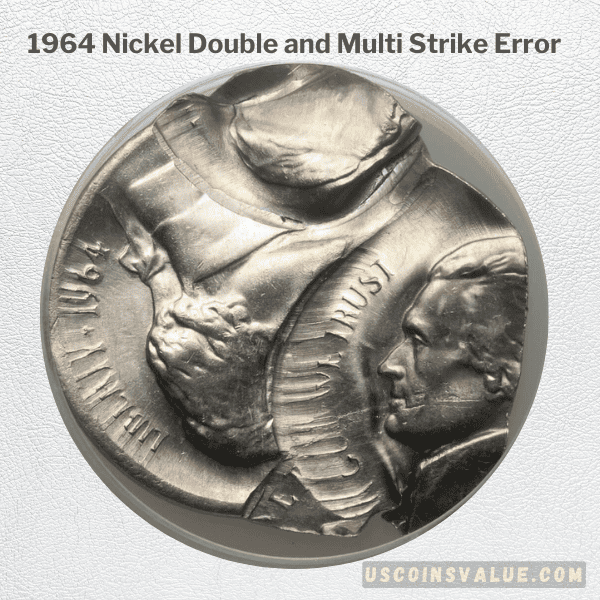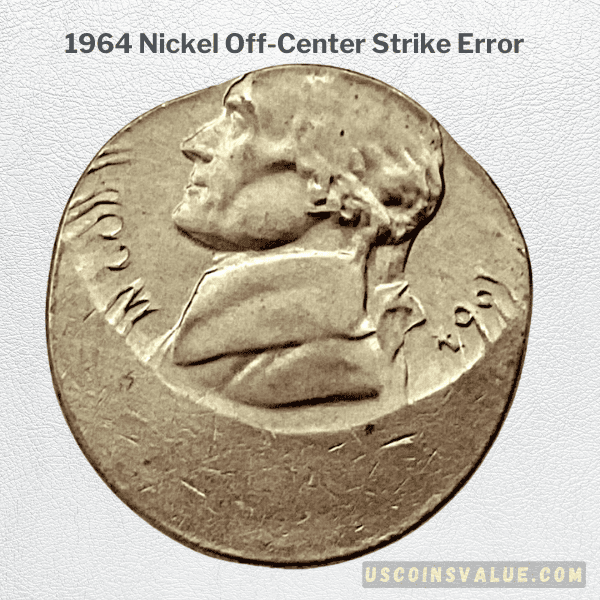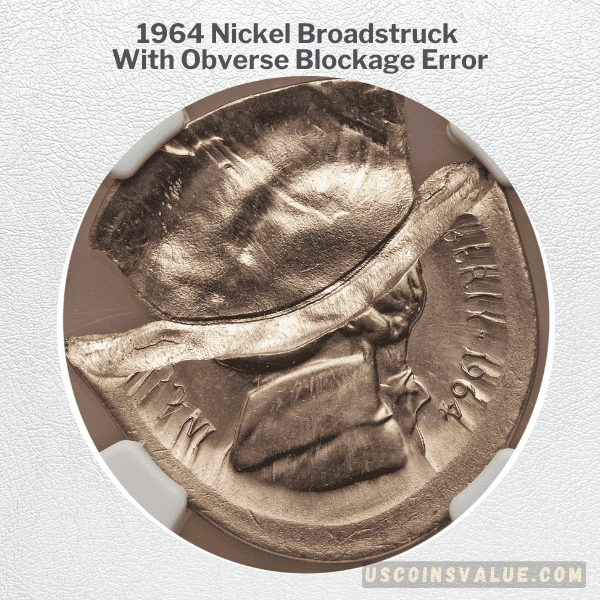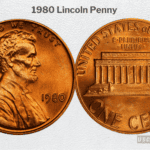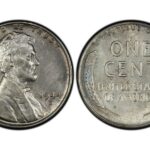Did you know that the 1964 nickels were the first nickels ever minted above the 1 billion mark? Yes, these nickels are the most abundant in the United States, exceeding over 2.7 billion coins, most of which were put into circulation.
On average, the 1964 Nickel Value is worth its face value of $0.05 (5 cents). So, you may be wondering, if that is the case, how come the most valuable 1964 nickel was auctioned off for $32,900 in a Heritage Auction in 2016?
Well, to answer that question, dive into this in-depth, comprehensive article that will let you know all that there is to know about the 1964 American nickel. Read on to dive into the nickel’s history, features, content, errors, and how much all of its varieties are valued today!
Background of the 1964 Nickel
The 1964 nickel, officially known as the 1964 Jefferson Nickel, is a President Thomas Jefferson five-cent nickel made in 1964. It features the third president on the obverse and his house ‘Monticello’ in Charlottesville, Virginia, on the reverse.
The design is part of the Jefferson Nickel lineup that began on October 3, 1938. This is considered the most iconic nickel series to have ever been made, more iconic than the Buffalo Nickel, Liberty Nickel, or the oldest Shield Nickel.
Of all things, 1964 nickels are known for their high mintage. More of these coins were produced because, in 1964, the U.S. faced a shortage of coins. To solve the problem, the U.S. Mint implemented a coin mintage date freeze.
The U.S. Mint employed a date freeze to restrict the production of new coin designs by producing 1964 coins for more than one year. 1964 nickels were not only issued in 1964 but also in 1965 and 1966.
During this period, production focused on the existing 1964 nickels in circulation, thereby producing billions of nickels for the first time in U.S. history.
Most 1964 nickels went into circulation since they were meant to do that. They solved the issue of coin shortage, but the mint had to release less uncirculated versions of the coin.
This is why it is hard to find 1964 nickels above MS65 grades; most went into circulation for decades and are now in bad condition.
1964 Nickel Features
1964 nickel specifications:
- Series: Jefferson Five Cents (1938 – 1964)
- Year of Make: 1964
- Mint Branch: Denver and Philadelphia
- Composition: 25% Nickel 75% Copper
- Weight: 5.00 grams
- Diameter: 21.21 millimeters
- Thickness: 1.95 millimeters
- Edge: Smooth/Plain
1964 Nickel Mint Varieties
The mint varieties are a list of all the coins made in various ways in various mint facilities in the country. For the 1964 nickel, the only mints used for its production were Denver and Philadelphia.
The mintage is as follows:
- Denver: 1,787,297,160
- Philadelphia: 1,024,672,000
- Philadelphia (Proof coins): 3,950,762
- Philadelphia (SMS coins): N/A
The 1964 nickel mint varieties made in these two mints include:
- 1964-D Nickel with Mint Mark – It was minted in Denver (D) and included a reverse design with a “D” mint mark.
- 1964-P Nickel No Mint Mark – Made in Philadelphia (P). It has no mint mark.
- 1964 (SMS) Special Strike Nickel – Made in Philadelphia, no mint mark, and features Satin finish coins.
- 1964 (Proof) Nickels – Made in Philadelphia, no mint mark, and features coins with the most superior finishes.
Obverse and Reverse Design
Felix Schlag designed the obverse and reverse sides of the 1964 nickel.
The obverse (heads) features Thomas Jefferson’s bust image facing the left. Inscriptions include:
- IN GOD WE TRUST – on the left of the image
- LIBERTY & ‘1964’– on the right of the image
The reverse (tails) features Jefferson’s ‘Monticello’ house image. Inscriptions include:
- E PLURIBUS UNUM – at the top of the image
- MONTICELLO– at the bottom of the house
- FIVE CENTS – below MONTICELLO
- UNITED STATES OF AMERICA – below FIVE CENTS
- ‘D’ Mint Mark – appears on the far right end of the house image
What 1964 Nickels Are Valuable?
There are only four things that make the 1964 nickel valuable:
- Unique Finish (Special Strike – SMS variety)
- Full Steps (F.S.) of Monticello
- Higher Grading Condition
- Desirable errors
Of these four, the SMS unique finish and Full Steps (F.S.) 1964 nickels are the rarest.
1. Unique Finish (Special Strikes- SMS variety)
1964 SMS nickels (1964 Jefferson Nickel Specimens) are rare Satin finish nickels with strong strikes, made specifically for collectors and numismatic purposes.
The first of this kind were discovered in the 1990s, and only 20 have been graded so far as of 2023. Collectors are hopeful that there are more to be found.
SMS are not as high quality as Proof coins, but they are part of the uncirculated collection – meaning if you are looking for a 1964 nickel in the highest grade, then these would be a good place to start.
So, how can you tell if a 1964 nickel is a special strike?
Special Strike (SMS) 1964 nickels were made with a unique Satin finish that is not present in other 1964 nickels. This finish gives the coin a bright color that isn’t dull. Also, the coin features sharp edges with detailed design details on the surfaces as well as crisper-looking strikes.
Use a magnifying glass to take a look at the SMS coin’s condition. A real 1964 SMS nickel will be flawless without any imperfections, contours, or irregularities on its entire surface. If you are unsure, the best way to 100% know if the coin is an SMS variety is to take it to professional coin graders like PCGS.
1964 (Proof) Nickels also have unique finishes, but they are not as rare as the SMS variety.
2. Full Steps (F.S.) of Monticello
1964 nickels with the F.S. designation are the rarest and most valuable nickels in this collection. In fact, all the ten-plus 1964 nickels that have sold at auctions for more than $5,000 have the F.S. designation. As of 2023, only five have been found at MS66 or higher.
“Full Steps”, F.S., refers to the level of completeness in the steps on the reverse side of a Jefferson nickel, on the image of ‘Monticello’, Jefferson’s home.
A 1964 FS Jefferson nickel has well-defined and fully separated steps (5FS- Five Full Steps or 6FS- Six Full Steps), which is a sign of a well-struck and well-preserved coin.
F.S. coins are available in three of the mint varieties, including 1964-D nickels, P nickels, and SMS variety.
Coins with a combination of these characteristics are highly valuable. In fact, the $32,900 nickel, the most valuable 1964 nickel ever, is an SMS coin with an F.S. designation.
3. Condition
1964 nickels are hard to find in higher grades. For example, PCGS has only graded thirty-five 1964-D nickels in MS66 grades and above.
The Sheldon’s scale is the industry standard for coin grading, where a coin’s condition is scaled from 1 to 70. This is the scale used by notable grading services like PCGS and NGC.
The 1964 Jefferson nickel is divided into four categories according to the Sheldon scale:
- MS (60 – 70) – stands for Mint State and is used to show the condition of circulation coins from grades 60 to 70.
- F. (60 – 70) – stands for Proof and is used to show the grade of Proof uncirculated coins with the most superior finish. P.L. (60-70) might be used to mean Proof Like finish of common circulation coins.
- P. (60 -70) – stands for Specimen and is used to show the grade for uncirculated coins that have less than Proof finish but more superior finish than M.S. coins.
Coins with M.S. grade and Full Step (F.S.) features are graded with both abbreviations, e.g., MS66FS. If this coin also features a proof-like P.L. finish, then it will be graded as MS66FS PL. An example is the MS66FS PL, one of two 1964 proof-like nickels known to date that sold for $3,840 at a Heritage Auction.
4. Desirable Errors
Most errors are common and not worth much; these include off-strikes, die chips, and double dies. However, a few 1964 errors are very rare and desirable, thus much more valued. The most valued error is the 1964-D 5C ‘Repunched Mint Mark’.
How Much Is A 1964 Nickel Worth Now?
The 1964 nickel value today is a minimal face value of $0.05 and a melt value of $0.0567.
However, since coins are valued higher than their intrinsic value by collectors and enthusiasts, the nickel’s value increases if it is in uncirculated mint state conditions, features the Full Steps designation, is a Special Strike, or has desirable errors.
On average, an uncirculated (MS+) Mint condition will cost more than $2, add a desirable error, and you have a $100+ coin; if it has both of these, then its $1,000+. Add SMS or F.S. designation into the mix, and you finally have a coin that will cost more than $5,000.
Below is a summary value chart showcasing 1964 nickels and how much they are valued according to the market knowledge of PCGS:
| 1964 nickels Grades | 1964-D (M.S.) |
1964-P (MS) |
1964 SMS (S.P.) |
1964 Nickel (Proof) (PR) |
| 60 | $2 – $20 | $2 | N/A | $4 |
| 61 | $2 – $22 | $2 | N/A | $4 |
| 62 | $3 – $24 | $3 | N/A | $5 |
| 63 | $5 – $30 | $5 | $2,000 – $6,750 | $6 – $8 |
| 64 | $10 – $50 | $10 | $2,250 – $7,350 | $7 – $10 |
| 65 | $16 – $650 | $15 | $2,650 – $7,850 | $8 – $14 |
| 66 | $30 – $1,350 | $65 | $4,000 – $10,250 | $10 – $16 |
| 67 | $1,600 | $1,150 – $5,500 | $6,500 – $14,500 | $12 – $24 |
| 68 | N/A | N/A | $23,500 – $31,500 | $17 – $35 |
| 69 | N/A | N/A | N/A | $28 – $275 |
| 70 | N/A | N/A | N/A | $600 |
Note:
- The N/A in columns without a price guide does not mean the coins are rare. Instead, it shows that there isn’t enough data or coins to publish an average price estimate.
- The grades (60 – 70) represent the particular coin’s grading prefix, i.e., MS60-MS70 for Mint State (M.S.), SP60-SP70 for Specimen (S.P.) special strike, or PR60-PR70 for Proof nickels.
1. 1964-D Nickel Value
According to NGC price guide, the 1964-D Jefferson nickel is worth $0.15 – $500 in Mint State (M.S.)condition.
No Proof Coins were made in the Denver Mint but they did include Prooflike nickels and F.S. varieties.
F.S. 1964-D nickels are valued between $30 and $1,350 in their most common grades – MS63 – MS66. Prooflike coins with F.S. designation only exist in MS66 grades so far – valued at $4,000.
MS67 is the highest grade with less than 10 nickels overall as of 2023.
Below are the highest historical auction records for the 1964-D nickel:
| Grade | Price | Firm | Sale Date |
| MS66 | $6,325 | Heritage Auctions | 2009 |
| MS67 | $4,025 | Heritage Auctions | 2006 |
| MS66 | $3,995 | Goldberg Auctioneers | 2014 |
| MS66 | $3,840 | Heritage Auctions | 2022 |
| MS66 | $2,350 | Heritage Auctions | 2015 |
2. 1964-P Nickel Value No Mint Mark
As of 2023, the NGC values the 1964 nickel from Philadelphia between $0.10 and $0.20 in circulated condition, between $0.25 and $500 in uncirculated mint state, and between $20 and $15,000 in F.S. designation.
Below are the highest historical auction records for the 1964-P nickel:
| Grade | Price | Firm | Sale Date |
| MS67 FS | $14,100 | Heritage Auctions | 2014 |
| PCGS Genuine | $9,700 | eBay | 2022 |
| MS67 FS | $8,519 | Legend rare Coin Auctions | 2019 |
| MS67 FS | $5,040 | Stack’s Bowers | 2021 |
| MS67 FS | $4,230 | Legend Rare Coin Auctions | 2021 |
3. 1964 SMS (Special Strike) Nickels
These coins were experimental and not meant for circulation. They are extremely rare with an auction value range of $7,500 – $14,400 in regular SMS strike and between $8,750 and $15,600 in SMS FS designation.
NGC grades the most common 1964 SMS nickels between MS65 and MS68 – valued between $1,750 and $5,750 in the open market.
The highest auction record is the $32,900 1964 SMS nickel, which is part of the legendary $223,700 Adams Special Mint Sets discovered in the 1990s.
Below are the highest historical auction records for the 1964 SMS nickel:
| Grade | Price | Firm | Sale Date |
| SP68 | $32,900 | Heritage Auctions | 2016 |
| SP68 | $31,200 | Stack’s Bowers | 2021 |
| SP68FS | $13,200 | Heritage Auctions | 2020 |
| SP67+FS | $22,800 | Heritage Auctions | 2019 |
| SP68FS | $17,625 | Heritage Auctions | 2016 |
4. 1964 Proof Nickels
Proof coins were included in the Philadelphia mint variety and are valued today between $8 and $275 in uncirculated Proof (P.R.) conditions.
The highest auction prices are above $400 and the most valued of them all are the DCAM varieties.
DCAM is used to refer to Deep Cameo coins which are coins with a frosted design (Cameo) effect that is particularly pronounced and stands out against the 1964 nickel’s background. DCAMs of any year or denomination are the highest-quality coins you will ever see on any U.S. Mint coin.
PR70DCAM has not yet been found for this year, the PR69 DCAM is the highest grade recorded by PCGS with just under 300 coins in existence.
Below are the highest historical auction records for the 1964 (Proof) nickel:
| Grade | Price | Firm | Sale Date |
| PR69 DCAM | $475 | eBay | 2021 |
| PR69 DCAM | $470 | eBay | 2021 |
| PR69 | $403 | Heritage Auctions | 2008 |
| PR69 | $345 | eBay | 2007 |
| PR69 | $345 | eBay | 2005 |
Most Valuable 1964 Jefferson Nickel Errors and Varieties
Coin varieties result from intentional mistakes or differences in design elements. On the other hand, errors are unintended mistakes that occur during the coin production process. Regardless, collectors often find both interesting and more valuable.
An example of a 1964 nickel variety is the 1964-D nickel: Repunched ‘D’ Mint Mark. This error was very common because of a different production element that was used at the Denver Mint.
Examples of 1964 nickel errors that happened unintentionally include the ‘Struck on a 10C blank Dime Planchet’ and ‘Struck on 1C Planchet’ errors.
Errors are very common and exist on any other coin ever made; this is why they are not as valuable as the coin varieties.
Below is the best 1964 nickel error & variety list:
1. Repunched Mint Mark Variety
Officially known as the 1964-D/D nickel RPM FS-501, F.S., the Repunched Mint Mark (RPM) is only found on the 1964-D nickels made in the Denver Mint.
The variety was formed when the ‘D’ mint mark on the 1964-D nickel was punched into the die more than once, creating multiple impressions of the same mint mark in slightly different positions.
An example is the MS66 coin that sold for $19,800 at Heritage auctions in 2022—similarly named and looking coins sold for $9,000 and $6,000 in 2021.
2. Struck on Wrong Planchet Error
A wrong planchet error occurs when a coin is struck on a blank planchet (the metal disc from which a coin is struck) intended for a different denomination or type of coin. Several different wrong planchet errors occurred during the making of the 1964 nickel.
A common one was the ‘Struck on 10C Planchet Error’ where the nickel was made by striking 1964 nickel dies on a silver dime planchet instead of a nickel planchet as was intended.
The coin ends up with 1964 nickel design elements but features an irregular shape due to the use of an unfitting planchet. It also features the color and weight of the wrong planchet.
An example of this is the 1964 5C Jefferson Nickel – Struck On A 10C Planchet that sold at Heritage Auctions for $646.25 in 2016. Coins with this error weigh approximately 2.4 grams instead of the 5 grams expected for a 1964 nickel. This is due to the different metal composition.
Other wrong planchet errors include the:
- 1964 5C Nickel ‘Struck on a 3.7-gram Copper Planchet’ (referred to as the 1964 copper-nickel) sold for $299 in 2005
- 1964 5C Jefferson Nickel ‘Struck on a Cent Planchet’ sold for $646.25 in 2016
- 1964 Jefferson Nickel ‘Struck on a Dime Planchet’ $552 in 2019.
- 1964-D 5C Jefferson Nickel ‘Struck on a Damaged 1940 Indian 1/4 Rupee’ -$1,600 in 2008.
- 1964 Nickel ‘Struck on a Philippine 10-Centavo Coin’ – $998.75 in 2014.
3. Improperly Annealed Error
Only one coin has been sold with this error, and we are yet to see others emerge in the auction market – the reddish-brown 1964 5C Jefferson Nickel ‘Improperly Annealed Planchet’ sold for $39 in 2008.
Improperly annealed errors result in the appearance of surface distortions like rough spots, weak strikes in the design, color variations, blistering, and cracks.
The error is caused when a blank planchet used to strike the 1964 coin was not properly heated and cooled during the annealing process.
4. Incomplete Clipped Planchet Error
Coins with this error sell on eBay for about $15.
A clip planchet error occurs when a portion of the blank planchet is “clipped” or missing due to the planchet being improperly cut or punched during the striking process.
There are different types of this, the common one being the ‘Curved Clip Planchet Error’ – where the clipped portion is missing in a curved or crescent-looking shape.
At the auction, the highest realized prize for this one was the 1964-D 5C Jefferson Nickel Incomplete Curved Clip, sold for $135.13 in 2013.
5. Double-Struck and Multi-Strike Errors
Multi-strike errors are mistakes that occur when dies and planchets are used to strike the same coins more than once, thereby creating the same images that have been struck repeatedly. In order to qualify as a multi-strike, the coin must have at least three strikes present.
Double-struck errors on the other hand are coins that are struck twice, if it goes more than twice then they become multi-strike coins. In both cases, the coins can be struck on-center or off-center.
An example of a multi-strike coins is the 1964 Jefferson Nickel ‘Four Strikes, Three Off Center’ sold for $1,200 in 2018. Another is the 1964 5C Jefferson Nickel ‘Triple Struck, Broadstruck and Off-Center’ sold for $499.38.
A good example of a double strike error is the 1964-D Jefferson Nickel ‘Double Struck on a 1C Blank – 3.1 grams’ sold for $411.
6. Off-Center Strike Errors
An off-center strike error occurs when the coin die fails to align properly with the blank planchet before striking, resulting in part of the design being struck off-center. This error can happen in various degrees, ranging from slightly off-center to severely off-center.
Examples include the 1964 5C Jefferson Nickel ‘Stuck 45% Off-Center’ sold for $195.50 in 2010, and the
1964-D Nickel ‘5% Off Center, Die Adjustment Strike’ sold for $172.50.
7. Broadstruck With Obverse Blockage Error
Broadstruck means that the blank was not firmly held down within the coining chamber. This causes the metal to flow outward in all directions during the striking process and leads to a coin with a larger diameter that is expected.
An obverse brockage error occurs when a struck coin adheres to the obverse coin die after it has been struck and is then struck again.
When the next blank planchet is fed into the press, the previously struck coin’s design is impressed onto the new blank. Together with broadstruck, the metal flows to cause a distorted almost unrecognizable coin.
An example is the 1964 5C Jefferson Nickel ‘40% Brockage Obverse and Broadstrike’ sold for $59 and ‘Broadstruck with Obverse Brockage’ sold for $161.
Frequently Asked Questions
1. Are 1964 Nickels Silver?
1964 nickels have zero silver content. They are made up of 25% Nickel and 75% Copper.
War Nickels, 1942-1945 nickels, are the only silver nickels ever made. They were made as part of the copper preservation program that sought to preserve copper, which was needed more in the war efforts of World War II. Silver was used instead of copper to make the 1942-1945 nickels.
2. Why Does My 1964 Nickel Have No Mint Mark?
All 1964 nickels with no mint mark were manufactured in the Philadelphia Mint, where mint marks were not used.
Philadelphia was the only coin-making mint in the United States before 1835, so mint marks were not needed to identify the source of a coin.
However, when other mints like Charlotte and New Orleans opened in 1838, the U.S. Mint started including mint marks to help identify which coins were made where. Even after this, Philadelphia kept its tradition of not including a mint mark.
This practice continued for decades till 1979, when the ‘P’ mark was included in the Susan Anthony dollar coin. However, this isn’t the first Philadelphia mint coin with a mark; that designation goes to the 1942 coins, which temporarily bore the ‘P’ mint mark before it was removed again in the subsequent years.
Final Thoughts
If you want to make a few bucks or a couple of thousand dollars, then look for 1946 nickels with F.S. designation, SMS Special strike, or rare errors like Repunched Mintmark.
Also, due to the 1964 nickel’s high mintage, these coins are likelier to lie around in pocket change than other rare nickels. All in all, coin hunting for the most valuable 1964 nickels will be worth your while and a fun walk in the park. Happy Collecting!

